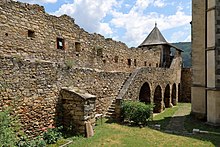Parish church Weißenkirchen in the Wachau
The parish church Weißenkirchen in der Wachau is dominant and dominates the place and is surrounded by a fortification with three corner towers in the market town of Weißenkirchen in the Wachau in the district of Krems-Land in Lower Austria . The Roman Catholic parish church , consecrated on the feast of the Assumption of Mary , belongs to the Deanery Spitz in the diocese of St. Pölten . The fortified church is a listed building ( list entry ).
history
After 1000 a chapel belonging to the parish of St. Michael from 987 was named. In 1159 a church belonging to the St. Florian monastery was named as the mother parish of the Wachau valley . In the second half of the 13th century, a church was built in the area of today's southern aisle. In 1258 Alberto von Kuenring renounced the church in Weißenkirchen in favor of the parish of St. Michael. By 1346 the church had its own priest. In the first half of the 14th century the church was extended to the north in the area of today's central nave. In 1439 a north aisle and in 1455 a north chapel were added. Around 1450 the church got its own parish rights. In 1502 the massive north-west tower was built. The late Gothic choir was built between 1519 and 1529. In the first third of the 16th century the weir system was expanded. In 1632 the church became an independent parish church and in 1665 received its own cemetery. In 1736/1738 the nave was redesigned in Baroque style. In 1793, the church roof was destroyed in a fire.
architecture
- Church exterior
The massive, multi-part church building with a late Gothic choir has a mighty west tower. The compact nave in the core from the 13th and 14th centuries with round arched light arcade windows bears a monumental, steep roof hipped to the west, in the south remains of a late medieval stencil frieze are preserved under the eaves. The core of the south aisle from the 13th century under a pent roof with a pointed arch slot has a richly barbed pointed arch portal from around 1500. In the south east of the south aisle, a two-axis late Gothic chapel extension from the end of the 16th century adjoins a gable roof with pointed arched windows. In the north there is a small late Gothic chapel extension from 1455. The monumental square northwest tower from 1502 dominates the church building, the tower is soaringly divided into five floors by cornices, on the first floor there are pointed arched windows with crab trimmings, the acoustic windows are pointed arched, the steep hipped roof has dormer windows. The main portal of the church is a pointed arch portal with a rich late Gothic pear rod profile and a set shoulder arch gate.
Furnishing
Only the red marble baptismal font in the right aisle and a statue of Our Lady from 1520 are preserved from the original Gothic furnishings. The black and gold high altar from around 1700 has a double column retable with a partially blown segmented arch gable on a continuous high base with sacrificial portals. The altarpiece, an oil painting on the subject of the Assumption of Mary, was probably painted by Karl von Reslfeld at the beginning of the 18th century. It is framed with four monumental saints depicting St. Joseph, St. Joachim, St. Johannes d. Baptist and St. Representing Anna. The pulpit is a work from 1742. On the basket there are reliefs depicting Christ on the Mount of Olives, Mary Magdalene and King David. The symbols of the four church fathers are shown on the sound cover .
organ
The rococo organ in green and gold was made by the Gatto organ building family around 1770 and restored by Pflüger Orgelbau in 2002, true to the original . In the literature there are different information about the year of manufacture and organ builder, because on the one hand there is a signature with "This organ was made by Mr. Joseph Gatto civil organ maker in Crems 1768" and on the other hand there is an invoice from 1775 by Ignaz Gatto the elder .
Weir system
The church festival with three multi-storey corner towers is the most important in Lower Austria. The late medieval complex was built in the first third of the 16th century and completed in 1533/31 and has largely been preserved except for the north side.
literature
- The art monuments of Austria. Dehio Lower Austria north of the Danube 1990 . Weißenkirchen in der Wachau, parish church Mariae Himmelfahrt, with floor plan, weir system, pp. 1256–1259.
Web links
Individual evidence
- ^ A b Parish Weißenkirchen: History from Weißenkirchen ; accessed on Nov. 27, 2019
- ↑ a b Dehio Lower Austria north of the Danube 1990 , p. 1258, ISBN 9783850283953
- ^ Burgenkunde.at: fortified church Weissenkirchen in the Wachau ; accessed on Nov. 27, 2019
- ^ Burgenkunde.at: fortified church Weissenkirchen in the Wachau ; accessed on Nov. 27, 2019
Coordinates: 48 ° 23 '53.1 " N , 15 ° 28' 12.8" E




